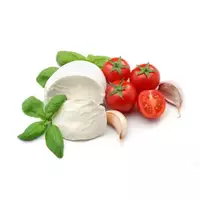Halumi cheese

Halumi or haloumi cheese, and there is also such a variant of the spelling of the name as halloumi, can be distinguished among the galaxy of famous cheeses produced for centuries on the island of Cyprus as one of the most sought-after and polar food products and far beyond the historical homeland. Halumi is traditionally made from milk from domestic goats as well as sheep.
It is worth noting that the halumi cheese also includes a small amount of cow's milk. Halumi cheese compares favorably against the background of other products made in Cyprus not only for its taste, but also for its consumer characteristics. Since the melting point of halumi cheese is high enough, the product is suitable for baking over an open heat.
Grilled halumi cheese will conquer any even the most sophisticated foodie with its rich taste and cheesy aroma. In its appearance, halumi resembles mozzarella cheese. The taste of halumi cheese is salty and light, the structure is airy and delicate. It is worth noting that halumi cheese is able, subject to the storage conditions of the product, to maintain its distinctive taste and consumer qualities during the year.
Halumi cheese is stored in brine, which helps to keep the initial taste and flavor parameters of the finished food unchanged. Connoisseurs of Cyprus' national cuisine know that halumi cheese works perfectly with fresh mint leaves. the plant enhances and at the same time shades the cheesy taste of halumi.
As noted earlier, in addition to sheep and goat milk, halumi cheese can contain cow's milk. Traditional Cypriot halumi cheese has a rounded shape. One halumi cheese head weighs approximately 270 grams. Notably, homemade Cypriot halumi contains some cow's milk, as opposed to industrial-made cheeses.
For this reason, in order to appreciate the true taste of the national delicacy of the inhabitants of the picturesque island of Cyprus, it is worth trying homemade halumi cheese. Increasing the content of cow's milk in the halumi composition significantly reduces the cost of production, and, therefore, the cost of the finished fermented milk product.
In cooking, halumi cheese is used as an independent food and served as a snack or dessert. In addition, halumi is an inapplicable ingredient in some traditional Cypriot dishes. Halumi cheese is used in salads, and necessarily grilled.
During the hot season, Cypriots eat halumi cheese with fresh watermelons. In this form, the product can be called dessert. Often halumi is served with smoked pork or de lamb, the so-called Cyprus sandwich without bread.
halumi cheese 255 kKal
Energy value of halumi cheese (Ratio of proteins, fats, carbohydrates - ju):
Proteins: 25 g (~ 100 kCal)
Fats: 16g (~ 144 kCal)
Carbohydrates: 2.6 g (~ 10 kCal)
Energy ratio (bj | y): 39% | 56% | 4%
 Español
Español Français
Français Português
Português Русский
Русский 简体中文
简体中文 繁體中文
繁體中文 日本語
日本語 한국어
한국어 العربية
العربية Türkçe
Türkçe Қазақ
Қазақ Deutsch
Deutsch Italiano
Italiano Українська
Українська
